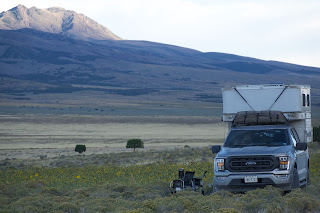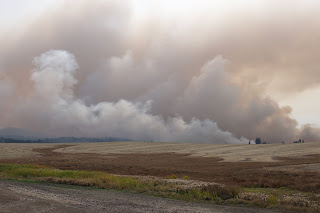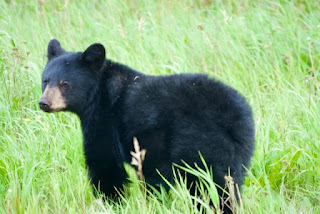 |
| Our favorite campsite with the Onaqui |
We have been reluctant to visit these wild horses since 2020. In 2021, the Bureau of Land Management declared them overpopulated and enforced a major cull. Using horribly inhumane tactics, they drove as many horses as possible with helicopters and ATVs into a corral area. In such round-ups, the horses are terrified by the noise and relentless onslaught, stampeding across broken ground in front of the machines. During this latest cull, half a dozen horses were put down on site because of broken legs. Stallions were separated from their bands. Mares were separated from foals. Over half of the 300-plus horses rounded up are now confined to government corrals because they are considered unadoptable because of age or health. It is a sad commentary on how these creatures are treated and how their freedom is ended, particularly when more humane ways to cull the herds exist and are used in other parts of the country.
It takes several years after a cull for the horses released back in the wild to re-establish territory and bands. We wondered if enough time had elapsed. Most often the horses remain so skittish around humans and vehicles that it is nigh on impossible to photograph them. We decided to take our chances.
We entered the area through the southeastern corner of the Great Salt Lake. The gravel road winds between mountains and flats.
 |
| Great Salt Flats |
We camped in a gravel pit during our first night. While walking Sam the next morning, I spied this tiny horned lizard.
 |
| Tiny horned lizard |
We drove through Fishing Creek Wildlife Refuge. Yet again, we were too early for the fall waterfowl migration. We saw lots of coots and a dozen or more Ibis-looking birds that were quite coy. I’ll wait until we’re home to name them.
 |
| Fishing Creek Wildlife Refuge |
We have a favorite campsite on a bluff, overlooking the Davis Mountains. We have had horses graze right past us in this spot. It also offers a great view of the area.
 |
| Our bluff-side camp |
The next morning, we found one of the herds along the Pony Express roadway near the Simpson Creek campground (please see our last post from David about the Pony Express). We were close enough to watch them from the road. At one point, two of the stallions got into a tussle and ran across the road, right in front of us. I love moments like this.
After the herd meandered past us, we visited several other places where we have seen herds in the past. But this time, the horses were being shy.
We went to our campsite and waited until morning. While driving to one of the watering holes, we spied the largest of the Onaqui herds not far off one of the gravel trails. David slowly drove the path, stopping the truck about 50 yards from the herd. To our delight, the horses grazed right toward us. At one point, one of the stallions grazed a mere twenty feet from the truck. Sam, although on high alert, was quiet and respectful.
It is such a privilege to be in the presence of the horses and to watch them interact. We watch several roll in the dust, then shake mightily, creating a cloud of dust.
We noticed a young filly with a gash across her chest. Hopefully it will heal. Her mother was very protective when several stallions spared nearby. It was the kind of encounter that few are able to enjoy.
 |
| Filly with a gash on her chest |
 |
| There's nothing better than a dust bath |
 |
| A sentinel stallion |
A cold front was due in by morning, but there was no prediction of rain. So we set camp in our usual spot. By sunset, however, a mountain of red clouds gathered in the south and rain was on the horizon.
 |
| Storm clouds turned red at sunset |
 |
| Storm clouds on the horizon |
By midnight, the wind picked up. An hour later, the truck was rocking and rolling against great gusts. Our pop-up soft side billowed and blustered violently. David and I both knew we needed to find better shelter.
We timed dropping the camper top between wind gusts. At two in the morning, we were making our way down a rugged four-wheel path under the beam of headlights, watching night creatures scurry in front of us. Sam was completely bewildered.
There is an area about ten miles away from our camp that is near the bottom of the valley and surrounded with juniper trees. We made our way for that protection and located a spot between junipers to safely pop the camper again. I was surprised that we were able to go back to sleep after all the drama. But the junipers surrounded us, offering their safety, and we drifted back to sleep.
 |
| Our safe camp, nestled between the junipers |
The next morning, all was calm, although the clouds were heavy. We located both herds, but they were all at a distance. With rain in the forecast, we decided to leave my beautiful horses. With its heavy clay base, this road is not to be trifled with in rain. It quickly turns to a sticky, slippery muck. So goodbye once again to my beautiful Onaqui horses. Vaya con Dios.
 |
| Onaqui stallion |








































